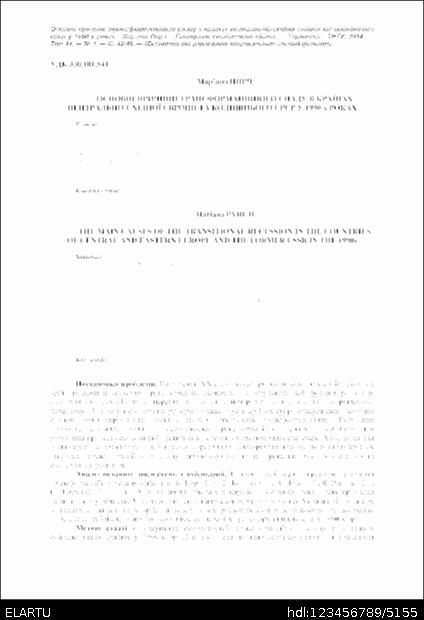Будь ласка, використовуйте цей ідентифікатор, щоб цитувати або посилатися на цей матеріал:
http://elartu.tntu.edu.ua/handle/123456789/5155

Повний запис метаданих
| Поле DC | Значення | Мова |
|---|---|---|
| dc.contributor.author | Pyrch, Mariana | uk |
| dc.date.accessioned | 2014-12-05T16:35:28Z | - |
| dc.date.available | 2014-12-05T16:35:28Z | - |
| dc.date.created | 2014-03-20 | uk |
| dc.date.issued | 2014-03-20 | uk |
| dc.identifier.citation | Пирч М. І. Основні причини трансформаційного спаду в країнах центрально-східної європи та колишнього срср у 1990-х роках / Мар’яна Пирч // Галицький економічний вісник — Тернопіль : ТНТУ, 2014. — Том 44. — № 1. — С. 42-49. — (Економіка та управління національним господарством). | uk |
| dc.identifier.citation | Pyrch M. The main causes of the transitional recession in the countries of central and eastern europe and the former ussr in the 1990s / Mariana Pyrch // Galician economic bulletin — Ternopil : TNTU, 2014. — Volume 44. — No 1. — P. 42-49. | uk |
| dc.identifier.uri | http://elartu.tntu.edu.ua/handle/123456789/5155 | - |
| dc.description.abstract | Статтю присвячено аналізу трансформаційного спаду в країнах Центрально-Східної Європи та колишнього СРСР у 1990-х рр., що був зумовлений переходом від командно-адміністративної до ринкової економічної системи. Спад виявився більшим у країнах колишнього СРСР, ніж країнах Центрально-Східної Європи. Глибина і тривалість спаду в окремих країнах визначалися такими чинниками: диспропорції в структурі виробництва і зовнішньої торгівлі; успадковані від попередньої системи початкові умови реформування; руйнування інститутів директивної планової економіки та відсутність нових – ринкових; розрив економічних зв’язків, характерних для командно-адміністративної системи; швидкість та послідовність втілення політики реформ; зовнішні політико-економічні чинники. Трансформаційний спад був меншим у країнах, що здійснювали економічні реформи в межах командно-адміністративної системи. | uk |
| dc.description.abstract | The article is devoted to the analysis of the transitional recession in the countries of Central and Eastern Europe and the former USSR in the 1990-s. It was caused by a transition from centrally planned to market economy system and appeared to be deeper in the Baltic states than in the CEE countries and deeper in other former Soviet Union countries, then the Baltic states. A depth and duration of the transitional recession in separate countries were determined by the actions of many interrelated factors. There is a structural approach to explanation of the transitional recession, according to which a liquidation of disproportions in pattern of production and foreign trade, which existed at the beginning of transition to market economy, resulted in falling of production volume. Some economists explain a large slump of production by speed and consistency of policy reforms. Other causes of economic decline were destruction of institutions of planned economy with a lack of new, market institutions, and damage of economic ties, typical for the previous economic system. A process of economic transition from planned to market economy was accompanied by severe external political and economic shocks (break-up of the Soviet Union, the Warsaw Pact and the Council for Mutual Economic Assistance), which also negatively influenced the dynamics of production. A depth and duration of the transitional recession were determined also by the initial conditions of market reforms, inherited from the previous system. Transitional recession was less in countries, which carried out reforms within the planned economic system. | uk |
| dc.language.iso | uk | uk |
| dc.publisher | Тернопiльський національний технiчний унiверситет iменi Iвана Пулюя | uk |
| dc.subject | економічна система | uk |
| dc.subject | трансформаційний спад | uk |
| dc.subject | «шокова терапія» | uk |
| dc.subject | економічні диспропорції | uk |
| dc.subject | структура виробництва | uk |
| dc.subject | економічна політика | uk |
| dc.subject | economic system | uk |
| dc.subject | transitional recession | uk |
| dc.subject | «shock therapy» | uk |
| dc.subject | economic disproportions | uk |
| dc.subject | production structure | uk |
| dc.subject | economic policy | uk |
| dc.title | Основні причини трансформаційного спаду в країнах центрально-східної європи та колишнього срср у 1990-х роках | uk |
| dc.title.alternative | The main causes of the transitional recession in the countries of central and eastern europe and the former ussr in the 1990s | uk |
| dc.type | Article | uk |
| dc.rights.holder | © „Галицький економічний вісник Тернопільського національного технічного університету“ | uk |
| dc.coverage.placename | Тернопіль | uk |
| dc.subject.udc | 330.101.541 | uk |
| Розташовується у зібраннях: | Галицький економічний вісник, 2014, № 1 (44) | |
Файли цього матеріалу:
| Файл | Опис | Розмір | Формат | |
|---|---|---|---|---|
| GEB_2014v44n1_Mariana_Pyrch-The_main_causes_of_the_42-49.pdf | 353,14 kB | Adobe PDF | Переглянути/відкрити | |
| GEB_2014v44n1_Mariana_Pyrch-The_main_causes_of_the_42-49.djvu | 115,58 kB | DjVu | Переглянути/відкрити | |
| GEB_2014v44n1_Mariana_Pyrch-The_main_causes_of_the_42-49__COVER.png | 6,31 kB | image/png | Переглянути/відкрити |
Усі матеріали в архіві електронних ресурсів захищені авторським правом, всі права збережені.